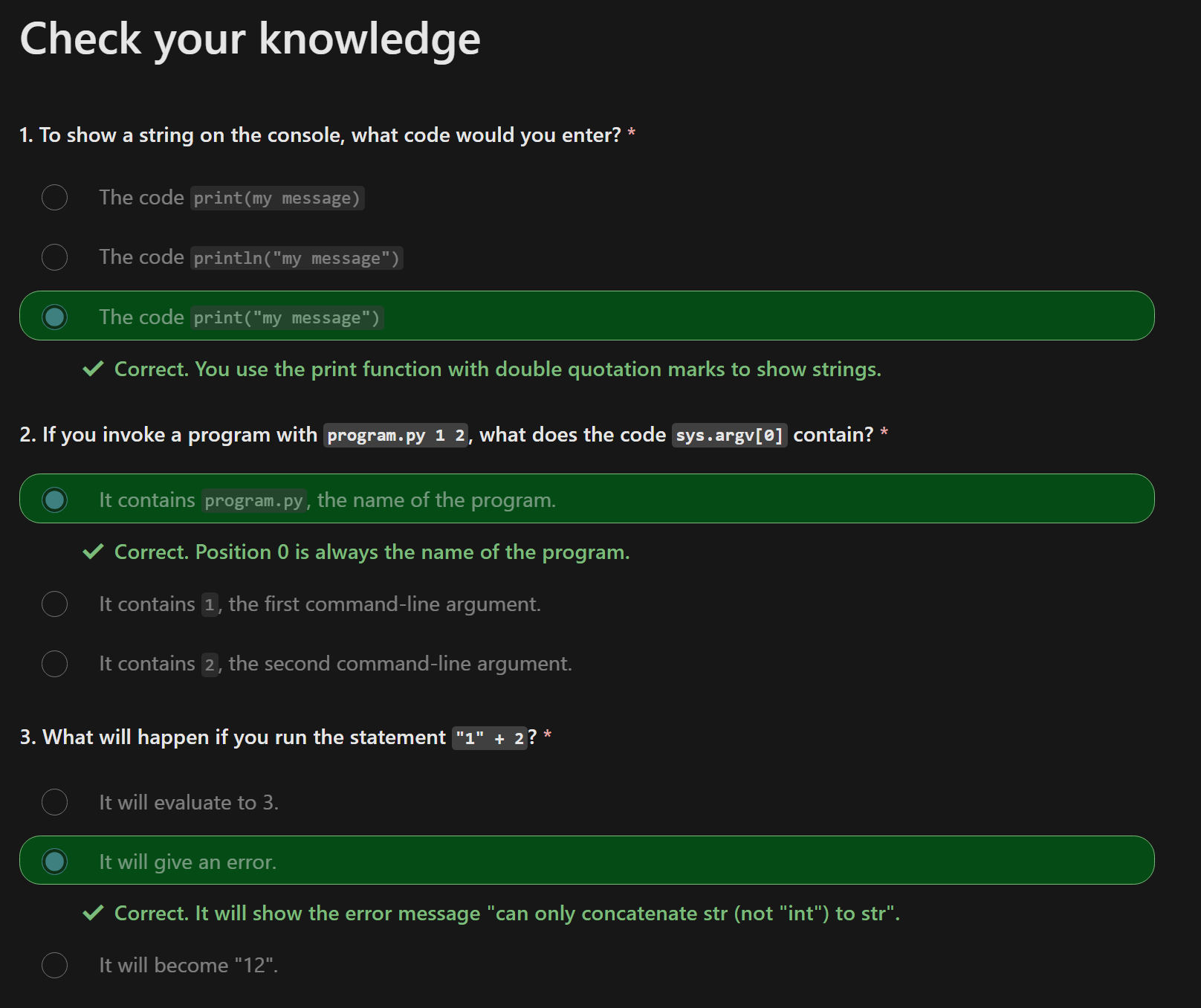Module 2: Write your own Python Programs
https://learn.microsoft.com/en-us/training/modules/python-create-run-program/
Introduction:
At some point you will need to build your own program in python that accepts user input and produces a result.
In this module, you are basically a brand new programmer who needs to write a series of utility programs for some senior staff.
You should learn:
- Use functions to manage input and output to the console
- Create variables to store data
- Distinguish between data types
- Use type conversion to convert between data types
A Python Program
You add a bunch of statements into a .py file and run it like this:
python your_program.py
The print() function continued
This is a complete function. You can call this anywhere. You need to use the () or it won't work.
Variables
This will store the equation inside a variable.
sum = 1 + 2 # 3
product = sum * 2
print(product)
Data Types
Each variable assumes a data type.

Some code as an example:
planets_in_solar_system = 8 # int, pluto used to be the 9th planet, but is too small
distance_to_alpha_centauri = 4.367 # float, lightyears
can_liftoff = True
shuttle_landed_on_the_moon = "Apollo 11" #string
How can you tell?
distance_to_alpha_centauri = 4.367 # looks like a float
Operators
You have a left side and a right side and an operator in between.
left_side = 10
right_side = 5
left_side / right_side # 2
Python uses two types of operators: arithmetic and assignment.
- arithmetic opertators -
+,-,*,/ - assignment operators -
=, +=, -=, /=, */
Dates
Use these for certain things within your application:
- backup - filename created on...
- condition - if Thursday, do x.
- metric - 5gb yesterday, 10gb today
To use a date, import the date module:
from datetime import date
date.today()
# or
print(date.today())
Data type conversion
Lets say that you try to print out today's date in a sentence:
print("Today's date is: " + date.today())
Doesn't work. Why? You're trying to concatenate a string with a date.
You'll need to convert the date to a string by doing this:
print("Today's date is: " + str(date.today()))
Exercise 2
# Display today's date
from datetime import date
print(date.today())
# create a converter :)
parsecs = 11
lightyears = parsecs * 3.26
print(str(parsecs) + " parsecs is " + str(lightyears) + " lightyears")
Collecting input
You can pass things into the program through the command line, like this:
python3 backup.py 2020-05-13
You can then retrieve the arguments by using the sys module:
import sys
print(sys.argv)
print(sys.argv[0]) # program name
print(sys.argv[1]) # first arg
This is the result of the code:
['backup.py', '2023-01-01']
backup.py
2023-01-01
User Input
A great way to have input into the program is to have the user supply it via prompts.
print("Welcome to the greeter program")
name = input("Enter your name: ")
print("Greetings " + name)
Then, run the program
python3 input.py
And then enter in the prompts
Welcome to the greeter program
Enter your name:
Working with numbers
If you have a program that enters in numbers, you need to remember to convert from string to int.
print("calculator program")
first_number = input("first number: ")
second_number = input("second number: ")
print(first_number + second_number)
You then run the program and get the concatenation:
calculator program
first number: 3
second number: 4
34
Here's the correct code for that program:
print(int(first_number) + int(second_number))
Rerunning with the correct code gives us this:
calculator program
first number: 3
second number: 4
7
Exercise 3: Collecting Input
You want to rewrite the code to accept any input, rather than just hardcoding in the variables.
parsecs = 11
lightyears = parsecs * 3.26
print(str(parsecs) + " parsecs is " + str(lightyears) + " lightyears")
# becomes
parsecs_input = input("Input number of parsecs:")
parsecs = int(parsecs_input)
lightyears = 3.26156 * parsecs
print(parsecs_input + " parsecs is " + str(lightyears) + " lightyears")
Knowledge Check
